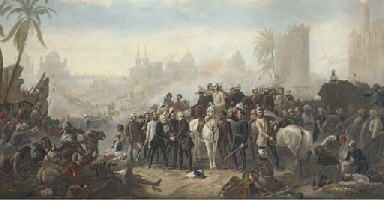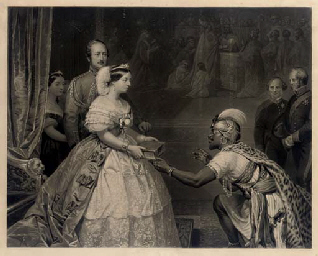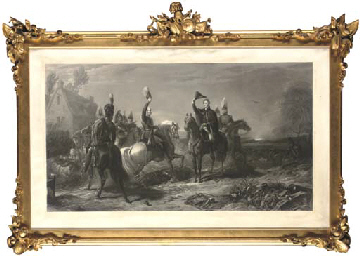AFTER THOMAS JONES BARKER [The Relief of Lucknow, & triumphant meeting of Havelock, Outram, Sir Colin Campbell] mixed method engraving by Charles George Lewis on chine appliqué, published March 25 1862 by Thos. Agnew & Sons, Manchester, Liverpool & London, signed by the artist and engraver in pencil, presumably proof before titles, framed and glazed in a period gilt wood and gesso frame, unexamined out of frame (occasional light surface soiling, two small repairs to lower margin). Image: 660 x 1250mm Sheet: approx. 830 x 1400mm The Indian Mutiny in 1857 was the first sign of British disaffection against British rule. It erupted at Meerut, near Delhi, and spread rapidly across North India. At Lucknow, the European and Christian population retired into the heavily fortified British residency, guarded by a small force of loyal sepoys. Finally, in mid-November, Colin Campbell Commander-in-Chief, conducted the exhausted garrison out of the city. It was not finally re-occupied until March 1858. The defence and relief of the Lucknow Residency became, understandably, a famous episode in British military annals. The subject of Thomas Jones Barker's oil painting, in the National Gallery in London, is the encounter between the three most popular heroes of the campaign, Colin Campbell James Outram, and General Sir Henry Havelock. Barker (1815-1882), the son of "Barker of Bath", was a popular painter of military subjects and battle scenes. Lewis (1808-80), the son of Frederick Christian Lewis was a prolific engraver, widely known for his numerous plates after the works of Edwin Landseer
AFTER THOMAS JONES BARKER [The Relief of Lucknow, & triumphant meeting of Havelock, Outram, Sir Colin Campbell] mixed method engraving by Charles George Lewis on chine appliqué, published March 25 1862 by Thos. Agnew & Sons, Manchester, Liverpool & London, signed by the artist and engraver in pencil, presumably proof before titles, framed and glazed in a period gilt wood and gesso frame, unexamined out of frame (occasional light surface soiling, two small repairs to lower margin). Image: 660 x 1250mm Sheet: approx. 830 x 1400mm The Indian Mutiny in 1857 was the first sign of British disaffection against British rule. It erupted at Meerut, near Delhi, and spread rapidly across North India. At Lucknow, the European and Christian population retired into the heavily fortified British residency, guarded by a small force of loyal sepoys. Finally, in mid-November, Colin Campbell Commander-in-Chief, conducted the exhausted garrison out of the city. It was not finally re-occupied until March 1858. The defence and relief of the Lucknow Residency became, understandably, a famous episode in British military annals. The subject of Thomas Jones Barker's oil painting, in the National Gallery in London, is the encounter between the three most popular heroes of the campaign, Colin Campbell James Outram, and General Sir Henry Havelock. Barker (1815-1882), the son of "Barker of Bath", was a popular painter of military subjects and battle scenes. Lewis (1808-80), the son of Frederick Christian Lewis was a prolific engraver, widely known for his numerous plates after the works of Edwin Landseer















Try LotSearch and its premium features for 7 days - without any costs!
Be notified automatically about new items in upcoming auctions.
Create an alert